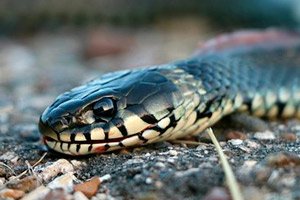
All iLive content is medically reviewed or fact checked to ensure as much factual accuracy as possible.
We have strict sourcing guidelines and only link to reputable media sites, academic research institutions and, whenever possible, medically peer reviewed studies. Note that the numbers in parentheses ([1], [2], etc.) are clickable links to these studies.
If you feel that any of our content is inaccurate, out-of-date, or otherwise questionable, please select it and press Ctrl + Enter.
Horror bite
Medical expert of the article
Last reviewed: 04.07.2025

There are a huge number of reptiles on our planet, to which grass snakes belong. They belong to the genus of non-venomous snakes, the family of snakes. In our area, grass snakes are very common. They can be found in forests, swamps, farmland, meadows, water. The peculiarity of this reptile, which distinguishes it from a snake, is the yellowish rim around the neck and round eyes (snakes have vertical eyes). Their average length reaches 100-130 cm and in females it is longer than in males. Can a grass snake bite?
Causes of a sting
By its nature, the grass snake is completely safe, although when meeting it, there is a chance of confusing it with a poisonous viper and losing vigilance.
He will never show any aggression at first, he runs away from people, but if his life is really threatened, he has several defense mechanisms: he hisses, releases a stinking liquid from his cloaca, can splash you with feces and pretend to be dead. In extremely rare cases, if he is cornered, he can bite.
The exception is the tiger snake, which lives in some eastern countries; its saliva is poisonous and when it bites with its teeth, like a snake, it also releases poison.
Symptoms of a sting
The structure of the maxillary apparatus of snakes and vipers differs in that poisonous reptiles have sharp teeth on the sides of the upper jaw, connected by a duct to a poisonous gland, capable of biting through human skin and injecting a dangerous liquid into it.
Grass snakes also have poison, but it is so weak that it does not pose any threat to human life.
When bitten by a snake, a person feels a prick, a mark remains on the body, and blood may flow from the wound. The body's reaction to it is insignificant: the symptoms consist of slight redness and swelling of the skin. In rare cases, an allergy in the form of hives or difficulty breathing may occur.
 [ 4 ]
[ 4 ]
Diagnostics of a sting
For people who do not distinguish between a grass snake and a viper, how can they understand who bit them? In fact, the symptoms are different. The signs of damage by non-venomous snakes are described above, and after a viper bite, in its epicenter, indicated by two or four red dots (depending on how many teeth have penetrated the body), after 15 minutes, severe pain begins, swelling, redness of the tissues, bruises appear. In addition, signs of toxic poisoning occur: the pulse quickens, spasms and shortness of breath, dizziness, fever, enlarged lymph nodes are possible.
Treatment of a sting
A snake bite does not require medical attention. It is recommended to wash the wound with soap under running water. It heals quickly if no infection gets into it. The appearance of hives or other allergic reactions is a reason to seek help at a hospital or take an anti-allergic drug.
Medicines
For the small number of those bitten who developed an allergic reaction, the following medications can be used:
- edem is an antihistamine drug that blocks peripheral H1 receptors. Not for use in children under 12 years of age, daily dose is 1 tablet, regardless of food intake. Side effects may include dry mouth, and rarely headache.
- suprastin is a drug with a mechanism of blocking histamine receptors. It can be taken by children from 3 years old, half a tablet 2 times a day, from 6 to 14 years old - three times, adults - a whole 3-4 times. Suprastin is contraindicated in glaucoma, stomach ulcer, arrhythmia, attacks of bronchial asthma. Negative reactions in the form of nausea, dizziness, increased fatigue, arrhythmia, tachycardia are possible.
Local symptoms are relieved with ointments or gels:
- elokom - cream with anti-inflammatory and antipruritic effect. Apply a thin layer to the skin once a day. Not for use on children under 2 years of age;
- Advantan is a hormonal ointment. It can relieve symptoms with a single application. It can be used on infants from 4 months.
Folk remedies
When going out into nature or on a hike, you need to not only take the first-priority medications to overcome possible health problems, but also arm yourself with basic knowledge of folk remedies.
For snake bites, you can use your own urine, it will disinfect the wound. At home, a soda solution will help, and in the field - a decoction of dead nettle or celandine.
A cold compress will help prevent swelling. To avoid infection, you can pick a plantain leaf, wash it well and apply it to the bite site.
Forecast
Grass snakes are harmless to humans, but if a bite does occur, it does not pose any threat to the person.

